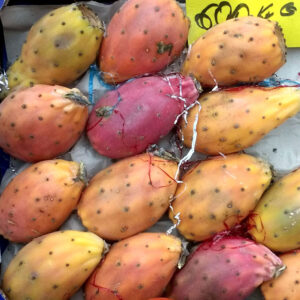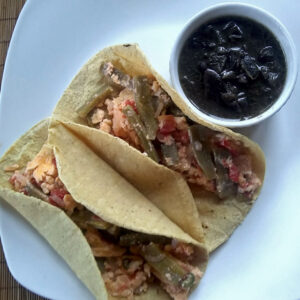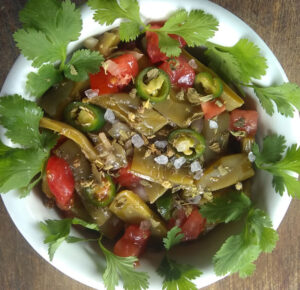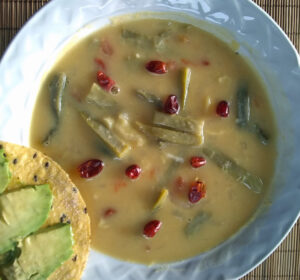A pickup truck full of cacti paddles was a common sight in northern Mexico during the dry season when I was growing up. Cattlemen would harvest them from the wild, throw them on a fire to burn the thorns, and feed them to their cows. Nopales (Opuntia spp.), from the Náhuatl word nōpalli for the pads, was in principle, drought emergency feed.
Spring, however, was the time of nopalitos, or little cacti paddles, the tender edible buds that perennial cacti produce during March and April. Considered a delicacy—much due to the fact that they were only available during that time of the year—I personally didn’t care much for them. As you must know, kids are not keen on vegetables, much the less something that is not sweet but rather acidic. Obviously, tastes evolve and understanding foods comes with age, so I developed a taste for them and now I love them! While writing this piece, I prepared a nopales salad (recipe below) and every ingredient’s flavor came out at different times and stood up proud until the mix produced an explosion of flavors in my mouth. I am not kidding.

Tunas
There are about 100 nopales species in Mexico, of which 60 are endemic. It is estimated that the annual per capita consumption of nopales in Mexico is around 14 lbs. Today, eating nopalitos is not reserved for the spring anymore, since some varieties of nopales have been domesticated and with the benevolent climate of Central Mexico, they grow year round. The varieties that are now cultivated allow you to eat the mature paddles and not just the spring buds. Within Mexico City limits, the municipality of Milpa Alta produces around 350,000 tons of nopales every year for the local human consumption. It’s a big and continuously growing market.
Aside from food and feed, nopales have turned out as one of those miraculous plants that some claim can save the world. Research shows that through fermentation, biodiesel or methane can be produced from nopales, both of which are green sources of energy. Other discoveries include biodegradable plastics, additives for chemical uses, and of course medical uses, specifically to control diabetes. Its high fiber content (around 37%) makes it a food that can help prevent liquid retention and lower cholesterol. My father, Don Alfonso, planted some nopales in the backyard of the house. He consumed them often during a period of 20 years as a natural way to control diabetes, with success. I personally have used the Nopales juice as an additive in preparing natural paint. My kitchen is a witness to that…
Notwithstanding that nopales protein content is only 2% and water content around 60%, they are considered by FAO a key element of food security because of its ability to survive in dry and semi-arid climates.
But despite the above mentioned multiple benefits, nopales are only consumed widely by humans in Mexico, yet Japan shows itself a promising market. Brazil, however, has extensively been using them to feed cattle—planting more than one million acres—but human consumption or alternative uses have not taken off in South America.
All these facts have not contributed to increase the human or animal consumption in other countries. In the USA, human consumption is observed among the ever-growing Mexican population but marginally in other ethnic groups. Nopales can be found in the ethnic food section in the supermarkets or search “edible opuntia” in your favorite online food platform.
Well, we hope to have awakened an interest in giving nopales a try, if not to produce biodiesel or feed cattle or make natural “plastics”, we would like you to enjoy them in savory dishes, as this versatile vegetable can be eaten in a soup, a salad, fiery breakfast tacos or added to your green juice. Ah! and its fruit, tunas, can be a wonderful dessert cold or in a sorbet! As usual, recipes provided below. Buen provecho!
Recipes
Note: with the exception of the tuna sorbet recipe, you will need 8 to 10 nopal paddles fresh and clean to prepare nopales breakfast tacos, a soup or a salad. Cut them in strips or bite-sized squares and boil them for 15 minutes with a bit of salt. Strain them and let them cool off in the strainer allowing the remaining juice to run off for 30 minutes. If desired, you may rinse them. You will have nopales cooked and ready to use in a variety of ways. Yield is about 16 oz.
Nopales con Huevo Breakfast Tacos

Ingredients:
4 oz. nopales cooked
4 eggs, beaten
6 tortillas, corn or flour
1 tomato, chopped
¼ onion, chopped
2 to 4 serrano chiles, chopped
Cooking oil
Salt to taste
Instructions:
Sautée the nopales, onion, tomato and chiles lightly. Add the eggs and cook to your taste. Serve over heated tortillas. Enjoy it with a good cup of coffee.
Yield: 6 tacos
Heat level: Medium to hot
Ensalada de Nopales

Ingredients:
8 oz. nopales cooked
2 tomatoes, sliced or roughly chopped
¼ onion, sliced thin
2 serrano, chiles sliced
Olive oil to taste
Balsamic or fruit vinegar to taste
A pinch of oregano
A sprig of cilantro, roughly chopped
Sea salt to taste
Instructions:
Mix the nopales with the tomatoes, onion, and chiles in a salad bowl. In a dressing bowl, mix two to three parts of olive oil to one part of vinegar. Then add the oregano, the cilantro, and the salt. Add the dressing to the salad bowl and let it rest for one hour in the refrigerator. Now it’s ready to enjoy…
Yield: 4 portions
Heat level: medium to hot
Nopales and Fava Beans Soup

Ingredients:
8 oz. dry fava beans
8 oz. nopales, cooked
2 tomatoes, chopped
½ onion, chopped
2 cloves garlic, minced
Cooking oil
Salt to taste
Chile piquín or chiltepín for garnish. You can also substitute chopped chile de arbol.
Instructions:
Rinse and soak the fava beans overnight, drain and reserve them. In a cooking pot, sautée the tomatoes, onion, and garlic. Add the nopales, the fava beans, and cover with water. Bring it to a boil and simmer for half an hour. If the fava beans are not cooked through, continue to simmer until done. Serve hot and garnish with the dry chiles.
Yield: 6 servings
Heat level: medium to hot
Tuna Sorbet
8 tunas peeled and cut in chunks. Do it in a bowl and reserve any runoff juice.
7 to 8 oz. caster sugar
1 to 1 ½ cup of water
Instructions:
In a saucepan mix the water and sugar. Dissolve the sugar in the water at low heat to produce a syrup. Reserve this. Push the tuna chunks through a chino or a strainer to separate the abundant seeds from the pulp. Blend the pulp with some of the syrup in a blender to produce a smooth mix. In a plastic bowl, place the tuna mix and whisk the remaining syrup into it. Place the mix in the freezer and stir every hour to prevent freezing. The sorbet should be ready in about three hours. Enjoy!
Yield: 2-4 cups
Latest posts by José C. Marmolejo (see all)
- Unconventional Seafood Salsas - 04/25/2022
- Cocineras Tradicionales: The Traditional Cooks of Mexico - 04/01/2022
- Carnitas Calientes - 03/11/2022











